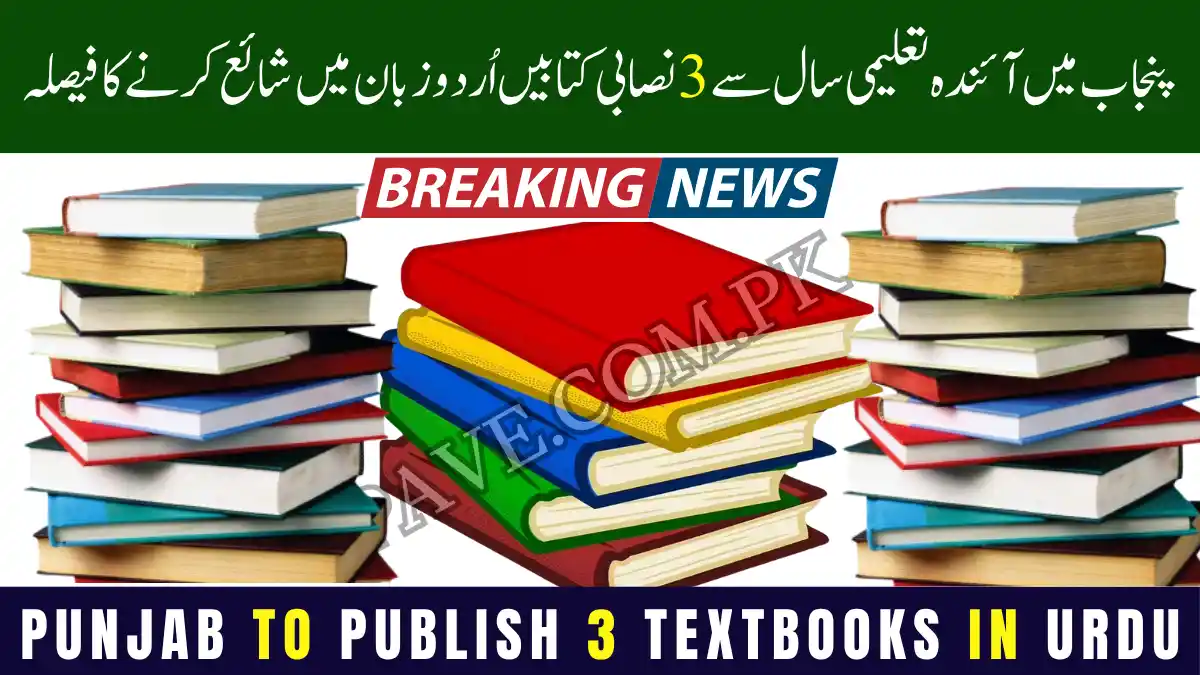Punjab to Publish 3 Textbooks in Urdu from Next Academic Year
The Punjab Textbook Board has announced a landmark decision that marks a major step toward educational inclusivity and linguistic accessibility. Beginning from the next academic year, three core subjects under the Single National Curriculum (SNC) — History, Geography, and Islamiat Workbook — will now be published in Urdu instead of English. This Punjab to Publish 3 Textbooks in Urdu decision aims to make learning easier, fairer, and more effective for students across the province.
Punjab Urdu Textbooks 2025 – Making Education More Accessible
Under the new initiative, the Punjab Urdu textbooks 2025 project will ensure that students of grades 6, 7, and 8 receive Urdu-language versions of these key subjects. The Punjab Textbook Board explained that this change was introduced after years of student and teacher feedback highlighting the difficulty of studying in English, particularly in rural and public-sector schools. The board emphasized that this reform will make comprehension easier for learners and reduce their dependence on external Urdu translation guides.
Addressing Challenges in English-Medium Learning
Many students, especially in government schools, have struggled to understand complex historical and geographical concepts because of limited English proficiency. Officials acknowledged that these language barriers often led to lower exam scores and rote learning habits. With the Urdu medium syllabus Punjab, the aim is to simplify the learning process and give every student an equal chance to excel regardless of their language background. Teachers also believe that the shift will encourage conceptual learning instead of memorization.
Punjab Curriculum Update – A Balanced Approach
This change is part of a broader Punjab curriculum update designed to balance linguistic accessibility with academic excellence. The provincial government has clarified that while Urdu will become the medium of instruction for selected subjects, English will continue to be taught as a key language skill. This balanced approach ensures that students maintain exposure to English while mastering essential subjects in their native language for deeper understanding. Education experts say this approach represents a more realistic path toward uniform education in Punjab.
Read More: Punjab Suspends Early Morning Sports Periods 2025 for Student Health & Safety
New Urdu Books for Schools – Printing and Implementation
The Punjab Textbook Board has already begun work on the new Urdu books for schools, ensuring that they will be printed and distributed before the start of the next academic year. Officials confirmed that printing contracts have been finalized, and distribution networks are being set up to deliver the books to schools across all districts on time. Teachers will also receive revised training materials and Urdu-based teaching guides to align classroom instruction with the new content.
Teachers Welcome the Reform
Educators across Punjab have widely praised the Punjab to Publish 3 Textbooks in Urdu decision. Teachers say it will make their jobs easier and enhance student engagement. In the past, instructors had to spend additional time translating English content into Urdu for their classes. Now, with officially translated editions, they can focus more on explanation and discussion rather than translation. This, they believe, will promote better comprehension and critical thinking among students.
Urdu Language Education Reform and Its Impact
The initiative is part of Punjab’s broader Urdu language education reform aimed at restoring linguistic confidence among students and promoting cultural identity. By introducing Urdu editions of these key textbooks, the government is aligning education with the linguistic reality of the majority of learners. Officials believe this shift will help students not only understand academic content better but also connect more deeply with their national and religious heritage.
Punjab Textbook Board Urdu Edition – Ensuring Equality
The Punjab Textbook Board Urdu edition rollout also serves as a strong message about educational equality. Previously, English-based textbooks favored students from private and urban schools who had stronger English foundations. By adopting Urdu versions, the board aims to level the playing field, allowing both urban and rural students to compete fairly. The decision supports the vision of the Single National Curriculum, which emphasizes uniformity and inclusivity in education across Pakistan.
Read More: Punjab Winter School Lunch Guidelines 2025
Bridging the Urban-Rural Divide
Officials have described this initiative as a long-overdue effort to close the academic gap between urban and rural students. In rural areas, where English exposure is limited, students often struggled to understand even basic textbook content. With Urdu as the medium of instruction, those same students will now be able to grasp key ideas independently. The Punjab curriculum update also ensures that examination boards and marking schemes will align with the Urdu editions to maintain consistency across the education system.
A Move Toward Conceptual and Fair Learning
Educationists have highlighted that this reform will shift Punjab’s education model from rote memorization to conceptual understanding. Students will now be able to read, analyze, and discuss lessons in their own language, which naturally enhances critical thinking skills. The new Urdu books for schools will also allow teachers to design classroom activities that focus on creativity, reasoning, and comprehension instead of simple memorization. This shift supports the long-term academic development of students.
Read More: Punjab Schools Introduce Indoor Classroom Break Policy 2025 Due to Smog & Cold Weather
Building an Inclusive Future for Punjab’s Education System
The decision by the Punjab Textbook Board reflects the government’s commitment to creating a fair and inclusive education system. By implementing the Punjab Urdu textbooks 2025 plan, authorities are ensuring that every student—whether in a private institution or a public school—has equal access to quality learning resources. Officials believe this will not only improve exam performance but also strengthen national cohesion through a shared linguistic medium.
Conclusion
The Punjab to Publish 3 Textbooks in Urdu initiative represents a historic reform in the province’s education policy. It prioritizes comprehension, equity, and cultural identity over outdated standards that favored English proficiency. By translating History, Geography, and Islamiat Workbook into Urdu, Punjab is ensuring that education serves its true purpose — to enlighten every student, regardless of background. This marks the beginning of a more inclusive, student-centered, and culturally grounded learning era for Punjab.







